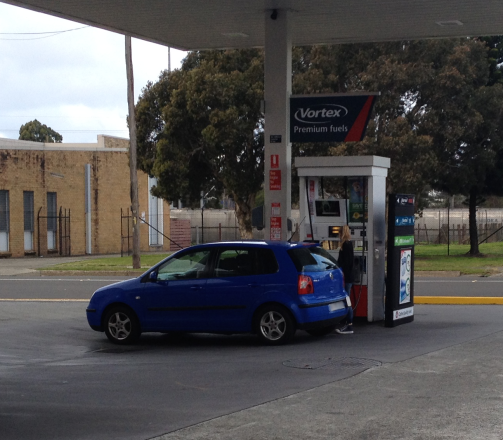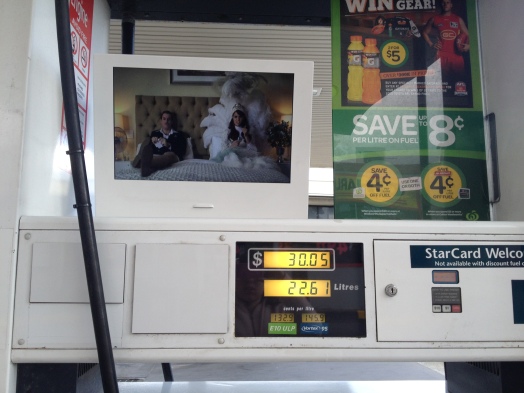“4-minute dwell time, 100% engagement” boasts Val Morgan about PumpTV, Australia’s first and only digital petrol station TV network that “engages, captivates and entertains” on-the-go consumers with “quality” content and advertising as they are filling their vehicles with petrol (Val Morgan 2013). PumpTV offers “one-to-one AV broadcast. No distractions” to people who are “100 per cent in a purchasing mind frame” (Val Morgan). PumpTV is proven to drive sales (Val Morgan 2013).
The proliferation of digital screens in public and semi-public urban  spaces has opened up a whole new world of exciting possibilities for the advertising industry. The advent of affordable, interconnected, high-definition digital TV screens has enabled content provides to deliver highly targeted messages to hard-to-reach consumers, activating a succession of commercial spectacles that punctuate the everyday itineraries of the shopper, the customer, the tourist and the commuter (Dupin 2011).
spaces has opened up a whole new world of exciting possibilities for the advertising industry. The advent of affordable, interconnected, high-definition digital TV screens has enabled content provides to deliver highly targeted messages to hard-to-reach consumers, activating a succession of commercial spectacles that punctuate the everyday itineraries of the shopper, the customer, the tourist and the commuter (Dupin 2011).
Intrigued to investigate the way people interact and respond to digital screens at petrol stations, I visited Woolworths Caltex in Unanderra on Saturday afternoon. While my Dad was inflating the tyres of his car, I used my phone to record people’s engagement with PumpTV.
At first, there was only one customer using the petrol pump, a young woman filling her blue Volkswagen which had a few friends inside. As I took a video and later some photos of the young woman watching PumpTV, I noticed the people inside the car all had their eyes on me. I immediately felt uncomfortable and stopped recording.
Unsure of how I would proceed, I decided to take some close-up shots of the screens. As I took a few photos, I heard a voice shouting, “Hey, what are you doing?” Suddenly, I noticed the service station attendant walking towards me. After explaining my intentions to her, she appeared quite interested and excited, admitting “I thought you were some kind of private investigator…I thought I was in trouble.”
With the approval of the service station attendant, I felt more confident and resumed recording (still from a distance, of course). However, after photographing a few more customers, I found the process had become monotonous. I was observing the same routine – people driving in, watching (or not watching) the screen while filling up, paying and leaving. I was disappointed that nothing exciting was happening, although I am still unsure what I had exactly expected.
As my Dad started to fill up his own car, the service station attendant came back out from the shop to talk to me. The lady eagerly explained that PumpTV was on a 90-second rotation, with its repetitive cycle causing her to tune out, “…more exciting and interesting content should be shown.” I also discussed with her the ethics of photographing and recording random people out in public. Putting her arm around my shoulder, she commented with a certain playfulness, “I know! Some people can get real cranky about that can’t they!”
The ethics of public space photography is, indeed, a contentious issue, with many people perceiving it as an egregious invasion of personal privacy (Sutton 2014). As a result, most photographers have established their own ethical guidelines which can be adapted to different situations (Sutton 2014). Photographer Ming Thein (2012), for example, never takes a photograph that is indecent, offensive or demeaning. Thein (2012) does, however, take street photographs without people’s permission and will often attempt to become anonymous, unmemorable and blend in crowds in order to prevent provoking his subjects.
While obtaining consent is an ethical practice, photographer Don Enright (2014) argues that it can have implications on the value of the produced work:
The act of asking permission invariably destroys the opportunity; you end up with something posed and stilted and uninteresting.
This is a problem I encountered in my own research. While I felt an ethical duty to ask people’s permission, I did not want people to feel obliged to watch the screens, resulting in expectancy or observer bias. Rather, I aimed to capture the natural movements of people filling up their cars and investigate how captive they were as an audience.
Rather than becoming entwined in ethical responsibilities, Enright (2014) practices public space photography as an art form – a means of documenting life in society at a particular place and time:
What I have captured…is a moment of humanity that allows me to project my own humanity upon [my subjects]. And by publishing the image, I’m allowing my viewers to do the same. All art is, ultimately, the act of holding a mirror to the face of society…
Through publishing images of my research in this blog post, I hope that readers can gain a deeper insight into the current “face of society” that Enright refers to. As public spaces become increasingly mediated, advertising also becomes harder to avoid. This was evident at the petrol station as customers were forced into spectatorship by their presence. At the same time, however, my discussion with the service station attendant reveals that digital screens are being treated as simply another element of ‘noise’, thus obscuring their potential value to advertisers.
It will be interesting to observe how these interactions will occur in the future as advertising practices become more sophisticated. This month, Val Morgan will be rolling out facial recognition technologies to almost 500 PumpTV’s, targeting ads to people filling their cars based on age, gender and mood (Clark 2014). Commenting on this development, Val Morgan’s managing director said “We can also measure the level of engagement, picking up if the person looks away” (Clark 2014). Indeed, something tells me it is not public space photographers that we should be concerned about.
Reference List:
Clark, L 2014, ‘For your eyes only: Val Morgan ramps up programmatic facial recognition ads’, Ad News, 25 March, accessed 7 September 2015, <http://www.adnews.com.au/adnews/for-your-eyes-only-val-morgan-ramps-up-programmatic-facial-recognition-ads>.
Dupin, F 2011, Digital signage: the right information in all the right places: ITU-T Technology Watch Report, ITU Telecommunication Standardisation Bureau, Geneva.
Enright, D 2014, ‘Paris and the Ethics of Street Photography’, Don Enright: Adventures in Tourism, weblog post, 28 July, accessed 7 September 2015, <http://www.donenright.com/paris-ethics-street-photography/>.
Sutton, DK 2014, ‘Is Street Photography A Violation Of Privacy, Or Ethics?’, David K Sutton Photography Blog, weblog post, 21 April, accessed 7 September 2015, <http://blog.davidksutton.com/594/is-street-photography-a-violation-of-privacy-or-ethics/>.
Thein, M 2012, ‘Street photography – the ethics of photographing random strangers’, Ming Thein Photography, weblog post, 21 July, accessed 7 September 2015, <http://blog.mingthein.com/2012/07/21/street-photography-ethics/>.
Val Morgan 2013, PumpTV, Val Morgan, accessed 7 September 2015, <http://pumptv.com.au/pumptv/>.























